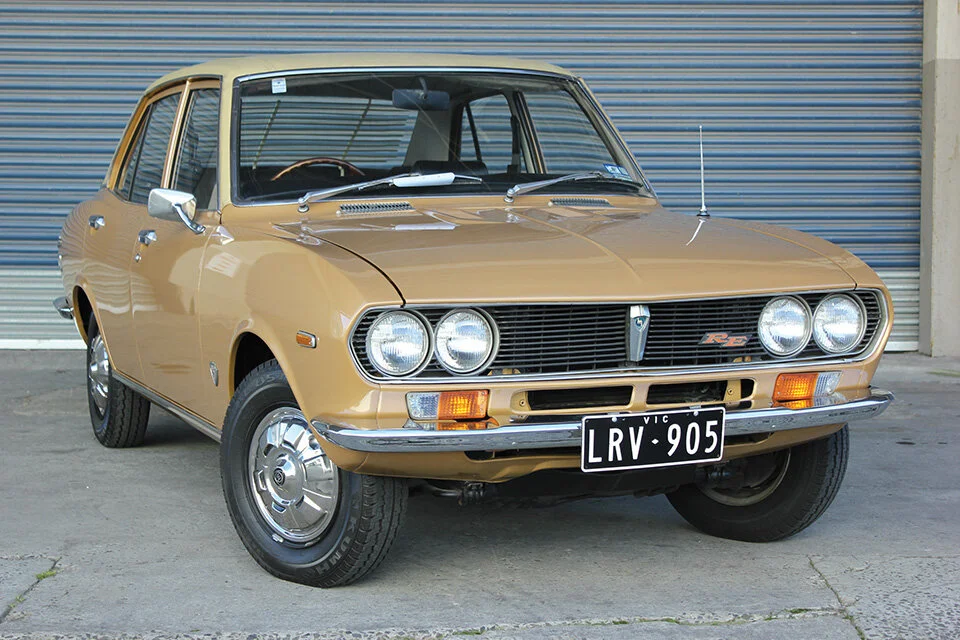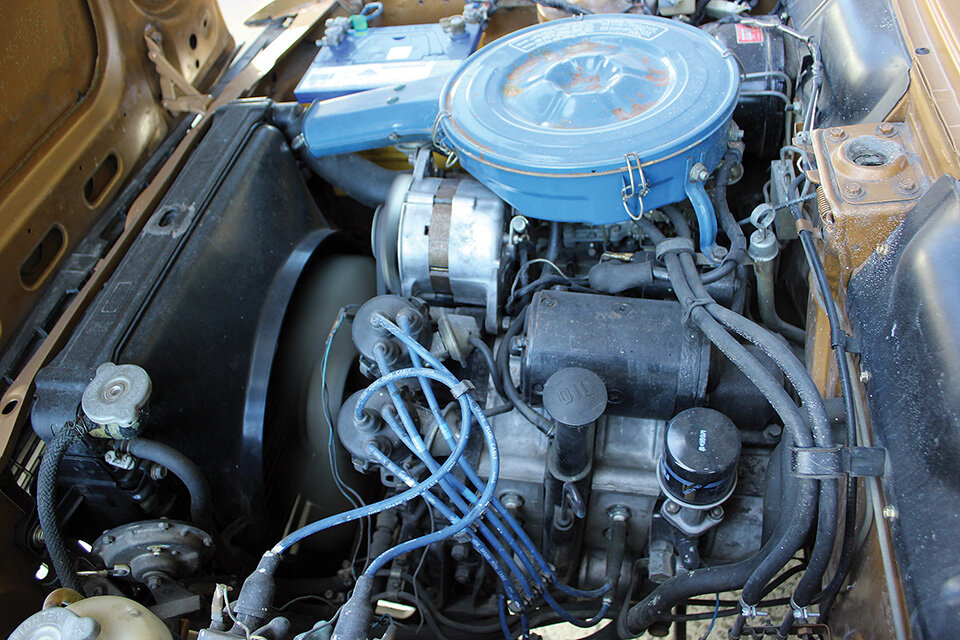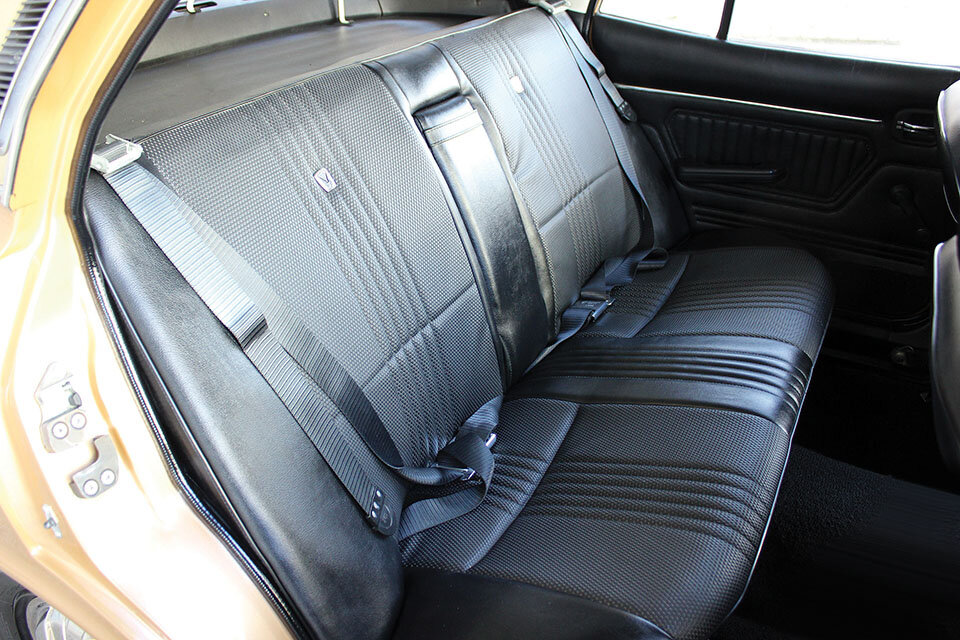power by rotary
After a well documented service history and showing less than 30,000 original miles on the clock at the time, Mrs J (June) Dumar sadly passed away, leaving her beloved RX-2 Capella at the Mazda dealership where it was in for its regular service. It then sat for a month, as it was turned down by many because it was an automatic before finally finding a new home.
FROM SURVIVOR CAR AUSTRALIA MAGAZINE – ISSUE #3
Early model unrestored and totally original Mazdas are certainly a rarity these days, even more so when powered by Mr Wankel’s unique rotary engine. Back in the day, Mazda Capellas were pitched at both younger ladies seeking their first new car and mature aged women needing a second smaller family car for their independence. The majority of sales consisted of cars made with the 4-speed manual gearbox, the automatic transmission option was rarely ordered making this ‘low mile’ RX-2 rotary powered automatic Capella quite rare today.
Mrs Dumar’s previous car was a white EJ Holden sedan also fitted with an automatic, which served her well for many years. When the Dumars decided to upgrade, they each treated themselves to a new Mazda from Penfold Motors Mazda in Burwood, Victoria. Mr Dumar (Fred) went for a red RX-4, whilst June opted for the Alexandrite Gold metallic RX-2 Capella sedan which she brought home two days after ‘Gala Supreme’ won the 1973 Melbourne Cup. Other than her weekly hair appointment at the salon, June hardly used her RX-2 Capella and that was only to trot up to the local shops occasionally. On the first service in early 1974, the RX-2 had barely clocked up 700 miles (698 miles to be exact). By 1979 she had only traveled around 1,250 miles per year totalling a ridiculously low 7,500 miles!
STAR OF THE HIGHWAYS
Released in Japan on 13th of May 1970, the RX-2 was Mazda’s first true rotary powered passenger car. The Capella name means the ‘brightest star’ taken from the Auriga group of stars seen only in the northern hemisphere. This led to marketing slogans such as the ‘Star of the Highways’. Capella is also the name of an African Antelope. The Capella series, which arrived on the Australian scene with a splash of publicity, saw the order books crammed full within days after the release. Victorian dealerships were moving about 150 rotary powered Mazdas a month. On its introduction, the automatic version RX-2 cost $3,814 which was at the time, amazing value. Originally the warranty period was for six months or 6,000 miles, but due to a high level of engine warranty issues when new, by 1972 Mazda offered an extended 24 month warranty on all rotary engines, or 24,000 miles; whichever came first. Mazda Australia introduced the Series II in late 1972, instantly recognisable by its twin headlight front. To identify an RX-2 the chassis number starts with a prefix of S122A whilst the piston powered Capella starts with SNA.
“June only used it to go to the hairdressers, and that was every Friday without fail!”
Due to larger porting and an extractor-type cast iron manifold, Aussie 12As made 130 honest horsepower which most drivers wouldn’t believe until a stopwatch was produced. With a light weight body of around 1,000kg, the RX-2 was reasonably quick at 16.3 seconds down the quarter mile. With this sort of performance the RX-2 was far beyond the opposition in its class. In order to find comparable game, the little car had to go hunting for bigger fish like the Holden GTR XU-1 Torana, Ford Capri V6 or the Valiant Pacer 245. The Jatco automatic slowed the RX-2 by only 1.2 seconds down the quarter mile.
Built in July 1973, it took a few months for Mazda Australia to import June’s RX-2 to our shores. Standard features on the RE Super Deluxe included full instrumentation, a sporty 3-spoke steering wheel with phony wood-grain, adjustable head-rests and wall to wall carpet. June decided to leave the plastic on the door trims and sunvisors, helping to preserve this Survivor’s interior in the same condition it was bought new. The backseat had never been sat in, as the Dumars had no children, only their poodles Mandy and Amy. Fred Dumar recalls laughingly, “June only used it to go to the hairdressers, and that was every Friday without fail!”
Fred and June would usually take the poodles back to the breeder in Rosebud, a 120 kilometre round trip, to have them bathed and clipped. He remembers taking the RX-2 on only two occasions which gave them the appreciation of what a great little car it was on the highway. “I once calculated that we must have done more than 20,000 kilometres taking our poodles down to Rosebud in my Mercedes over the years,” joked Fred.
Garaging it, and having it regularly serviced right up until 2010 at the same Mazda dealership, saw this Survivor clock up an incredibly low 29,979 miles. Due to the lack of use, it did need the spark plugs changed regularly due to it fouling them and running rough, the carburettor and brake master cylinder also needed overhauling. When Mrs Dumar passed away aged 86, the Capella was in for its scheduled service. Mr Dumar called to advise them that he had no further use for it and that he wished to sell the RX-2. “It then sat for a month, as it was turned down by many because it was an automatic before finally finding a new home” says the Service Manager of Penfold Mazda. The RX-2 then went through a succession of hands eventually ending up in New South Wales with its current owner.
Continuously registered in Victoria from new until 2013, it still has its original issue black and white LRV-905 Victorian number plates. The original push button radio still works perfectly which tunes into the air-waves through the factory standard electric aerial. Original rear venetian blinds have survived four decades preserving the interior from the harsh Australian sun. The matching numbers 12A rotary engine spins to life incredibly smooth with a soft purr giving no clue as to the amount of power waiting to be unleashed. “Give your hand a rest and order a rotary engine with a new powerful automatic T-bar transmission” proclaimed Mazda marketing for the RX-2 Capella back when it was new. The automatic transmission makes this RX-2 easy, and a pleasure to drive, especially knowing it is one of the few remaining Survivors left like this as most others have now been heavily modified and customised with bridge-ported high performance turbo rotary engines, and after-market alloy wheels.
Getting your hands on an unmolested Survivor could prove quite a challenge, yet we wonder how many other ‘low mile’ rotary powered Mazda Survivors are still out there in the hands of our senior citizens, locked away in a garage somewhere, sitting unused and unneeded waiting for an enthusiast to breathe a new lease of life back into them…?






